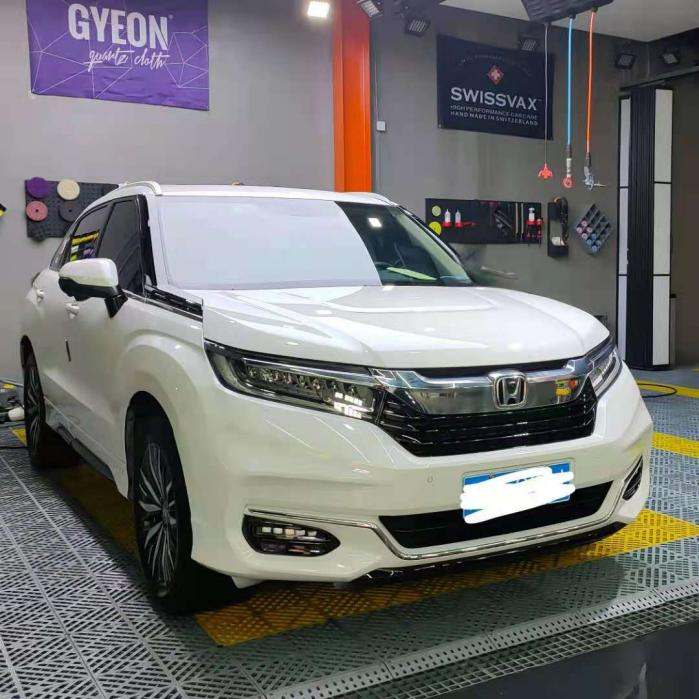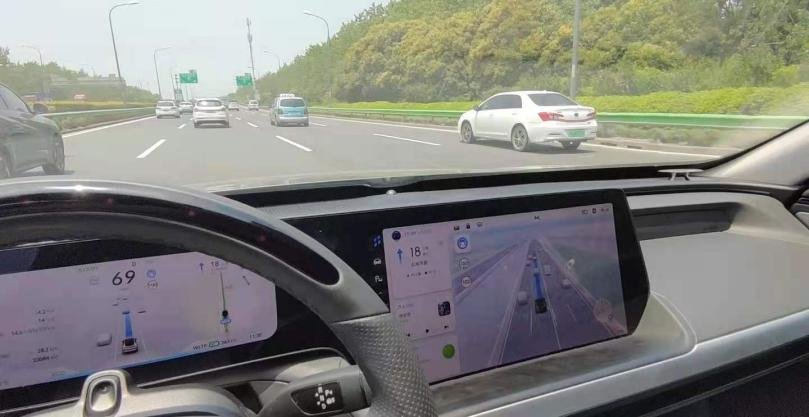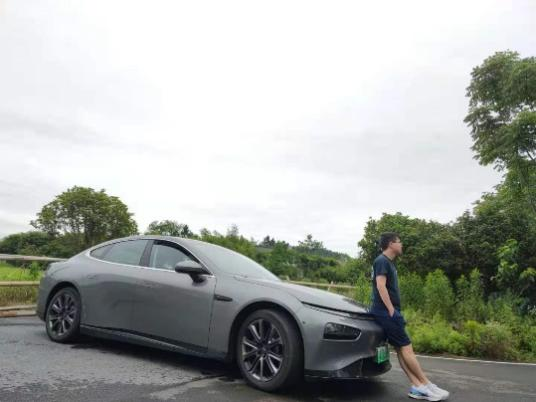Thank You Message to 42 Garage and XPeng Auto
At the beginning of the article, I would like to thank 42 Garage and XPeng Auto for providing such a great testing activity for their fans. As a standard gasoline car owner, P7 has brought me and my family a lot of shock and the experience of “future travel”!
First of all, I would like to introduce my own car usage: Currently, our family’s car is a 2020 Guangben Guandao 370 high-end edition, replaced in June last year. Because the community where we live is newly built with charging piles, we have considered new energy vehicles when we changed cars last year.

But at that time, the delivery period of Model 3 was too long, and the car demands of our family of three (my elder brother, my sister-in-law, and me) were full of uncertainties. There was no car model that could meet our endurance requirements, so we had to give up.
After all, none of us wanted to get bogged down in meaningless family disputes due to forgetting to charge, insufficient endurance requiring one person to get off the car, or too much power consumption while driving.
After a year, I was fortunate enough to get the endurance king P7, and I think I can compare and explore its advantages and disadvantages in a more comprehensive way.
In 2018, I drove a Roewe ERX5 with an NEDC endurance of 320 kilometers from Shanghai to Hefei for more than 7 hours. I carefully planned charging stations and endurance throughout the journey, and when I arrived, there were only 70 kilometers left. This can also be regarded as an interesting story in the prehistoric period of new energy vehicles.
Our Large Honda for Comfort, Space, and Household Use
First, let’s talk about the cost of car usage: I am sure everyone knows that oil prices have been skyrocketing since the Chinese New Year. The private petrol station I often go to has risen from over 4 yuan to 6.5 yuan. In this case, although our car has 280 horsepower, a powerful 2.0T VTEC engine, and eco-mode has always been used, compared with it, the charging price has been stable between 1 yuan and 1.5 yuan. Occasionally, there are activities or stacked coupons, and 78 cents is also common. Not to mention the maintenance of a gasoline car every 5,000 kilometers, which costs several hundred yuan each time and takes several hours, and the service attitude of 4S shops and the far distance are very vexing. I looked at the maintenance manual in the car, which has a basic frequency of about half that of a gasoline car, and fewer items.

High Gasoline Prices and Parking Fees Often Make Me Give Up Driving.Recently, I just picked up my car for a whole year and drove more than 19,000 km. Based on my driving experience this week, I calculated the cost of using the car. I saw that XPeng car owners have a certain amount of free charging quota every year on the internet, so the cost of using the car must be more cost-effective.
Of course, for someone like me who has public charging piles in the neighborhood, charging is definitely not difficult. Small communities with charging conditions are actually very limited. I remember a salesperson telling me before that only about 30% of car owners in Shanghai can easily charge at home. The remaining 70% are either dealing with property management disputes, insufficient power supply, fire control problems, lack of parking spaces, and other special situations that make it impossible to install charging facilities.
Unfortunately, there are fast charging piles near my home and company (all high-quality piles with a current of 200A+), so I really can’t feel this kind of experience. However, the 576 km (WLTP) of endurance should be enough for daily work, at least not too worrying in spring, summer, and autumn. My experience is that checking the comments on the App before going to an unfamiliar charging station can effectively avoid trouble.
XPeng provides two endurance display schemes, namely NEDC and a stricter WLTP. The full electric range of the two is 670/576 km, respectively. It is worth noting that XPeng’s performance endurance is calculated based on theoretical values, which means that the full electric range is always 576 km in WLTP mode. Tesla, Volkswagen ID4, and other models will dynamically estimate the endurance based on driving habits, battery aging, and in-car electrical appliances, which can undoubtedly better assist drivers in charging planning. In practical experience, high-speed power loss in WLTP mode is basically 1:1.3, and complex congested road conditions are about 1:1.1. It may be higher by 20% in winter.
After talking about cost and usage, I want to talk about my feelings about the features of the car, especially the smart cockpit and assisted driving.
Since we purchased the Honda, we have hit the car machine or cursed at it more than once in despair. Because it always gets stuck, navigates incorrectly, lose internet connection, overheats, has weak logic, etc. Although it also uses 4G data and comes with pre-installed Apps such as Kuwo Music and Amap, I have never taken the mobile phone holder off the car.
It is really hard to imagine that this and P7 are products from the same era. I have experienced the car machines of several new forces in the past, and the interaction is really user-friendly. Although the voice assistant may not be so intelligent, the main functions can still be achieved. At least this week, I did not use mobile phone navigation, and most of the needs could be met by speaking.
However, compared with the car machines of other three mainstream new energy vehicles, XPeng’s car machine seems somewhat unprofessional: more like a large Android tablet.First of all, the operation logic is very unclear. For example, the settings are divided into system settings and vehicle control. Some key controls are in the system settings (which require a second-level page to find), while vehicle control has a lot of unnecessary things, such as lighting color and exterior lighting language. Is it really necessary to put these functions here? Little P often can’t directly control some detailed functions, and related pages won’t pop up automatically even when asked.
In addition, the functions are too scattered. The original intention may have been to allow car owners to remember and directly click to enter, but it is too complicated to do so when not familiar with the car. I think NIO has done the best job among new forces. The simple color matching and card-style operation make all functions clear at a glance. Tesla’s system is also handy except for its foolish voice assistant and translation tone. XPeng has always boasted about its intelligent technology, but its system logic doesn’t seem to be much different from that of BYD.
There are also many assisted driving test videos online. Let me talk about my own feelings: I specifically tested the car-rich and car-scarce environments in the three major scenarios (city, expressway, and highway) during this week’s experience. Needless to say, the experience was very good on the expressway and highway with fewer cars. NGP can independently and accurately complete overtaking, interchange navigation, speed adjustment, and the style is more biased towards experienced drivers.
However, when there were more cars, the lane switching and overtaking became too frequent. The distance between cars on the highway is large, and it is difficult to detect the road conditions more than 300 meters away based on visual fusion, so frequent lane changing not only increases risk, but may not be faster. Perhaps personalized lane changing logic can be introduced to let users choose how frequent they want the lane changes to be. The car-following feature works very well in congested scenarios, except for cutting in line, which may lead to some discomfort.
The most uncomfortable scenario is when the traffic is somewhere between congested and smooth (around 60-80 km/h on the highway and 40-60 km/h on the ring road), which tests the logic and comfortable handling of actions such as overtaking, acceleration, and avoidance. The P7 performs poorly in this scenario, mainly manifested in: hesitating to change lanes, dizzy acceleration and deceleration control, and easily missing the ramp. Especially on multi-lane roads, the overtaking logic is too aggressive and cannot be personalized or canceled in one-click. The markings on urban roads often change, and from my observation, high-precision map updates are relatively not timely, so the vehicle often cannot make accurate judgments.

It is a single-side dashed line on the high-precision map, but it has actually been changed to a dotted line.Unexpectedly, XPeng impressively provided a one-year-old P7 with over 20,000 kilometers to us for experience, which seems to dispel my doubts about the overall vehicle quality.
During the week-long journey of 1,150 kilometers with the P7, I even slept twice in the car while slacking off from work. Altogether, I might have spent over 24 hours inside the car. I also gave some friends a ride to introduce them to the P7. Although everyone has different aesthetic preferences, they praise the vehicle’s technology and driver assistance systems as well as the performance and convenience of the electric drive.
I think this is just like the 42nd Garage’s slogan, “New energy vehicles are changing more people’s future travel!” In addition, driver assistance systems should not only provide assistance but also offer visual, auditory, and tactile reminders. This is also one of XPeng’s advantages. Advanced driver assistance features such as NGP navigation assistance and automatic parking require passing an exam in the app to ensure that users have a full understanding of the privileges of the human and vehicle. When the system is turned on or off, a voice prompt of “NGP has been turned on/off” or “ACC has been turned on/off” will be played. When takeover is needed, the driver will also hear “Please take over immediately,” followed by a “beep” and seatbelt tightening to remind them. XPeng’s efforts and rigorous approach to this whole set of assistance interactions are worth praising.
Over the course of the week, there were no obvious abnormal noises, looseness, or other quality issues with the P7. Although there were some imperfections in the assembly details, such as large gaps in the ambient lighting, stuck console box switches, and insensitive air conditioning vents, considering that these are the earliest batch of P7s (manufactured in July 2020), these issues are understandable. My own car also experienced problems such as a loose steering wheel, ineffective anti-pinch windows, and detached interior trim panels during this year. As a complex industrial product, cars are bound to have some minor issues, as long as the manufacturer can promptly carry out repairs.

This article is a translation by ChatGPT of a Chinese report from 42HOW. If you have any questions about it, please email bd@42how.com.
